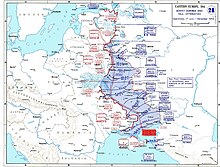This is an old revision of this page, as edited by Gary123 (talk | contribs) at 14:35, 2 September 2018 (→See also). The present address (URL) is a permanent link to this revision, which may differ significantly from the current revision.
Revision as of 14:35, 2 September 2018 by Gary123 (talk | contribs) (→See also)(diff) ← Previous revision | Latest revision (diff) | Newer revision → (diff)| The Kuban Bridgehead | |||||||
|---|---|---|---|---|---|---|---|
| Part of the Battle of the Caucasus on the Eastern Front of World War II | |||||||
 Map of July–December 1943 positions of the Eastern Front. The Kuban Bridgehead starts by Novorossiysk | |||||||
| |||||||
| Belligerents | |||||||
|
|
| ||||||
The Kuban Bridgehead (German: Kuban-Brückenkopf), also known as the "Goth's head position" (German: Gotenkopfstellung), was a German position on the Taman Peninsula, Russia, between the Sea of Azov and the Black Sea. Existing from January to October 1943, the Bridgehead formed after the Germans were pushed out of the Caucasus. The heavily fortified position was intended as a staging area for the Wehrmacht which was to be used to renew attacks towards the oil wells of the Caucasus. The bridgehead was abandoned when the Red Army breached the Panther–Wotan line, forcing an evacuation of the German forces across the Kerch Strait to Crimea.
Prelude
Case Blue (Fall Blau), launched 28 June 1942, saw Army Group South divided into two Army Groups, Army Group A and Army Group B, the former participating in the Battle of the Caucasus. Throughout the operation the German situation, especially that of Army Group B centered on Stalingrad, began to deteriorate. As Army Group B began collapsing in the North, Army Group A quickly found itself at risk of being flanked. It was forced to abandon its task of securing the oilfields of the Caspian, and began withdrawing down the Terek River toward the Taman Peninsula.
Bridgehead
| Invasion of Crimea and Caucasus | |
|---|---|
Following the encirclement of the 6th Army at Stalingrad, Army Group A withdrew towards the Black Sea and Crimea. The 17th Army, commanded by Richard Ruoff and Erwin Jaenecke, constructed a defensive position across the Kuban River delta in the Taman Peninsula, which was completed in January 1943. The main, first defense line started by Novorossiysk and run roughly northwards all the way across the peninsula. Consisting of 5 defense lines, the total depth of the defense area was up to 60 km. German forces, moving from positions along the Terek River, fully occupied the new defensive network in February 1943 while under constant attack by the Red Army . The bridgehead, originally intended to provide a staging area for future attempts to gain control of the Caspian oil fields, was re-tasked on 3 September 1943, as the German situation on the Eastern Front continued to deteriorate. The Kuban Bridgehead then served to evacuate German forces as the withdrawal of Army Group South to the Dneiper Line had become inevitable.
The first defenses of the Kuban Bridgehead were breached on September 15–16, 1943 in the area of Novorossiysk during the Novorossiysk-Taman Operation [ru] of the Soviet North Caucasian Front. The Taman Peninsula was completely cleared of German forces on 9 October 1943.
The defense of the Kuban Bridgehead permitted the evacuation of 239,699 soldiers, 16,311 wounded, 27,456 civilians (nearly all Russian population of Novorossiysk able to work), 115,477 tonnes of supplies (including ammunition), 21,230 motor vehicles, 74 tanks, 1,815 guns, and 74,657 horses to the Crimea. The Luftwaffe, operating from a field airport at Slavyansk-na-Kubani, withdrew a further 15,661 men. Transportation over the narrowest point of the strait, measuring four kilometers, was done by Marinefährprahm ferry barges and a sea cableway. A combined road and rail bridge was constructed, but was destroyed shortly before completion in October 1943.
See also
References
- ^ Encyclopedia of World War II: A Political, Social, and Military History. Oxford, England: ABC-CLIO. 2005. p. 307. ISBN 1-57607-999-6.
- ^ Tessin, G., Verbänd und Truppen der deutschen Wehrmacht und Waffen - SS im Zweiten Weltkrieg 1939-1945, Biblo Verlag, Osnabruck, 1977. taken from http://www.cgsc.edu/CARL/nafziger/939GXXP.PDF pg 10
- Weinberg, Gerhard L. (2005). A World at Arms: A Global History of World War II Second Edition. New York, NY: Cambridge University Press. p. 456. ISBN 978-0-521-61826-7.
- ^ Encyclopedia of World War II: A Political, Social, and Military History. Oxford, England: ABC-CLIO. 2005. p. 307. ISBN 1-57607-999-6.
- ^ "Новороссийско-Таманская наступательная операция (9 сентября — 9 октября 1943 г.)"
- Weinberg, Gerhard L. (2005). A World at Arms: A Global History of World War II Second Edition. New York, NY: Cambridge University Press. p. 605. ISBN 978-0-521-61826-7.